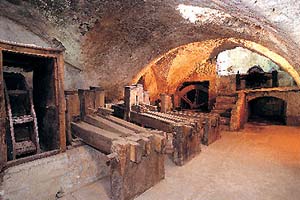1
| 2 » |
In 1759 a notary act reports a detailed description of an Amalfi paper mill in that era, it consisted of various rooms each with a precise phase of the work: the room of the “pile”, a large stone beater, that of the “tino”( a large vat) , the “stracciaturo” , the boiler, the workshop, the “asciugaturo” and the “spannituro” (the drying room).
The basic materials were cotton, linen and hemp, these were gathered in special stone sinks called “pile”. The sink was filled with water and the rags reduced to pulp by a series of wooden mallets with iron tips, produced by the Iron-works or in the forges of Pogerola.
 |
Magli |
The time taken to beat the mixture and the shape and size of the tips of the mallets determined the consistence of the pulp and the weight and thickness of the sheets of paper. The mallets functioned using the force of water falling from the big wheel that in counter weight transferred the movement to a shaft of transmission called “fuso” that in turn moved the mallets.
In a second phase the pulp was passed on into a large vat in brick, lined with majolica where it was mixed with substances that bleached the mixture, and an animal glue was added that was produced in the boiler room.
The workers with bare hands lowered into the vat a grill of bronze or
brass wires bordered with wood, a “ cassio”, that became covered
with a layer of pulp when extracted (the water passed through the grill).
All the different formats had a water mark in the centre, the producers
trade mark that was only visible against the light, and was used to represent
not only the paper manufacturer but also the type of paper produced.
Today we can still see examples of these old water-marks in the Museum,
the motif most used was the shield of Amalfi and also those of the Noble
houses of Amalfi.
1
| 2 » |